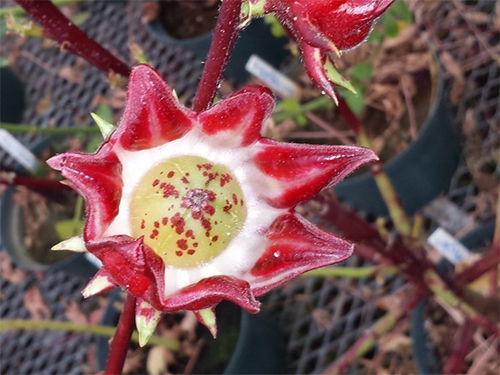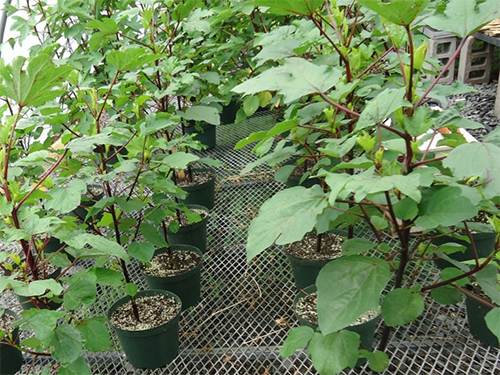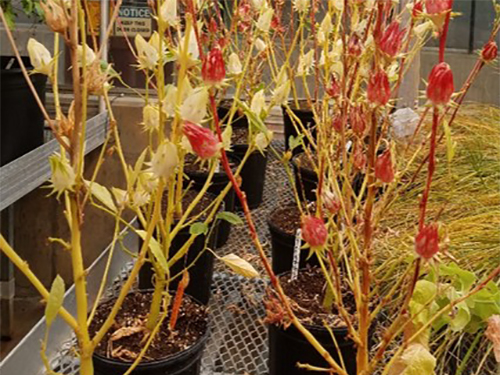
Fact Sheet FS1298
Quick Facts
Other Common Names for Roselle: Florida cranberry, gongura, Guinea/Indian/Jamaican/red sorrel, karkadi (or karkade), lemon bush, natal roselle, Queensland jelly plant, roselle hemp, sorrel, sour-sour, zobo.
Origin: Uncertain - Either Sudan in Africa or India/Malaysia in Asia
Core Nutritional Value: The leaves, calyx (flower bud cover or sepals) and flowers are rich in pigments (esp. anthocyanins) and antioxidants; high in iron, magnesium, and Vitamins A and C.
Major Uses: The leaves are used for food preparation; the calyx and flowers for tea, flavoring, and coloring
Major World Producers: China (East Asia), Sudan (Africa) and Thailand (Southeast Asia)
Suitable U.S. Growing Areas: USDA Plant Hardiness Zones 3–11
Major Consumers: Africans (Burkina Faso, Ghana, Liberia, Mali, Niger, Nigeria, Senegal, Sierra Leone, Sudan, etc.), Asians (India, Thailand), Caribbean (Trinidad and Tobago, Guyana, Antigua, Barbados, Belize, St. Lucia, Dominica, Grenada, Jamaica, St. Kitts and Nevis), Europeans (esp. Germany), Hispanics (Mexico), and other ethnic groups in the U.S.
Introduction
Roselle (Hibiscus sabdariffa L.) is an annual or perennial shrub in the Malvaceae (cotton or okra) family. It is a major cash crop in China, Sudan, and Thailand and a minor vegetable crop in several other tropical and subtropical countries around the world. The origin of roselle is unclear. Some ethnobotanists identify Sudan in North Africa as the center of origin (Mohamed et al. 2012) while others suggest India to Malaysia (Morton 1987). There are two major strains: Hibiscus sabdariffa var. altissima Wester which is important for the high quality fiber, and H. sabdariffa var. sabdariffa which is important for food uses. All roselle types have traditional medicinal values; and applications vary widely among cultures all around the world. This fact sheet focuses on three broad roselle types that are particularly suitable for New Jersey: H. sabdariffa var. sabdariffa: ruber with red or variegated edible calyx, and albus with green edible calyx; and Indian Green (Hibiscus cannabinus), a kenaf that is more important for the high quality fiber.
Uses
The calyx and flower are used for tea, jam, jelly, juice, wine, syrup, gelatin, pudding, cake, ice cream, flavoring, and coloring. In some parts of India the leaf is the primary plant part used for human consumption. The young leaves are used in a manner similar to spinach with the leaves mixed with other vegetables and food condiments for human consumption. In Thailand, tea made from the dried flower is a major drink. Sudan is currently the leading producer of roselle in Africa where the flower and calyx have wide applications in the food and drink industry. In West Africa both the leaves and flowers are the plant parts that are used in food preparations. In Liberia it is important for the leaves, while in Senegal and Nigeria the flowers and calyx are harvested. In Southwestern Nigeria the young calyx is parboiled, dried, and mixed with other vegetables and condiments for a highly delicious meal. In most Nigerian homes, when roselle calyces are available, it is a substitute for meat or fish! In Senegal, dried calyces are processed into a tasty beverage that is considered to be highly therapeutic. In Europe, Germany is the leading importer of roselle calyx for food coloring and flavoring. The United States currently imports approximately 5,000 metric tons of dried roselle calyces annually for use in brewing herbal teas (Chin 2008).
Plant Characteristics
Roselle is naturally a perennial plant but is commonly cultivated as an annual. In studies at Rutgers University, the Indian Green (IG) which is kenaf (Hibiscus cannabinus) flowers readily after 12–14 weeks in the greenhouse or in the field, but the Indian Red (IR), African (Zobo) Red (AR), and African Green (AG) types take much longer to flower due to their sensitivity to day length. IR, AR, and AG types begin to flower as the day length becomes substantially shorter; usually from late September to early October. The plant is in full bloom from mid to late October and the fruit matures in November/December. Due to this late flowering IR, AR, and AG may be propagated to full maturity only under warm temperature and therefore are more appropriately adapted to tropical or subtropical climates. These roselle types do not produce mature flowers and fruit under New Jersey conditions. On the other hand, IG (kenaf) if planted early (May 15–June 15), should attain full maturity under New Jersey conditions. Leaf shapes vary among roselle types and kenaf. The plant normally starts with a simple single-lobed leaf. As it grows bigger, the leaves develop three to five lobes. In the greenhouse the leaves become smaller at fruit maturity and the number of lobes is reduced to one.
Propagation
Roselle is relatively easy to grow from seed. Germination takes five to 10 days depending on type and temperature. For maximum success planning in the field, it is advisable to raise plants in flats in the greenhouse, and after four to six weeks transplant seedlings in the field. Roselle plants grow well in sandy loam to loamy sand soils with pH from 5.5–6.8. Organic matter level should be >1%. It is prudent to carry out a soil test long before crop establishment to confirm the suitability of the location chosen for crop cultivation. Plants may be grown under conventional tillage or no-till practices. Space plants about 36" x 18" in the field and, at 2–4 weeks after planting, apply fertilizer based on the results of your soil test. Closer spacing is recommended where early vegetative growth is desired.
If planted on bare ground, weed control is crucial in the first 6–8 weeks after planting. Chemical or manual weed control practices must ensure minimum weed interference with the newly planted roselle at this early growth stage. Once fully established, the plant canopy of the roselle will suppress future weed interference. Roselle is generally tolerant of insect attacks, but one should scout the field regularly for leaf-feeding insects and control them with recommended treatments as soon as they appear. Disease problems are also rare in roselle plants. However, it is always important to be vigilant and take note of any unusual symptoms so one can take appropriate control measures. There are currently no pesticides registered for pest/disease control in roselle, so physical removal and disposal of affected plants are recommended. Nutrient deficiencies, chemical damage, or other abiotic disorders may be confused with disease problems. Seek expert advice to ensure proper diagnosis and any possible treatment of the problem. Diagnostic services are available at Rutgers Plant Diagnostic Laboratory.
Leaf Harvest and Handling for the Market
In New Jersey a major niche market for roselle leaves is the Asian Indian population. In this community, roselle is known as "gongura", and the leaf is the main attraction. Leaf harvest may begin as early as six weeks after transplanting or eight weeks after direct seeding. At harvest, the main shoot and branches are cut back with a sharp knife or cutter and allowed to regrow. Subsequent cuts are done at 2–3 week intervals until the frost in late October or early November. Cut branches/leaves will retain freshness only for a few hours after harvest. For this reason, the cut ends must be dipped in water or the whole foliage kept in cold storage (45–50°F or 4°C) soon after harvest. If dipped in water, the cut branches/leaves will retain freshness for 24–48 hours. From our observations if kept in cold storage (45–50°F) the leaves may retain freshness for 7–10 days.
Yield
A good crop of roselle generates 6–8 lb fresh leaf weight/plant at 12–18" spacing in seedbeds spaced 36–48" apart under plastic mulch, with good weed management between the plastic rows. The total leaf fresh weight is estimated based on 3–5 harvests over a 12-week period (August–October in New Jersey). If conditions are ideal, a higher yield is possible.
Market Opportunities
There are many specialty food market opportunities for roselle leaf in New Jersey: farmers markets; bodegas (roadside/street markets); and Indian groceries, restaurants, and brokers. For the farmers market, cut branches/leaves may be bunched similar to whole-plant spinach, or sold individually by weight. The latter strategy is more cumbersome for both the grower/marketer and the consumer. For other markets, the cut branches/leaves are packaged in well-aerated 5–15 lb/box units. The "harvest-your-own" marketing option is not common and not likely to be a major option for roselle production, as the grower must ensure that the plants are not destructively harvested by untrained customers. Currently the market for the red roselle types is much larger than for the green types due to cultural preferences.
Flower Harvesting and Handling
Roselle may be grown for flower and seeds in New Jersey only in heated greenhouses. Without artificial lighting, roselle flowers in October/November and seeds will mature in December/January. Growers may harvest fully open flowers along with the bracts and calyx when the plant resumes flowering. At full bloom, flowers may be harvested every 2–3 days and harvesting may continue for four to six weeks until the plant senesces (enters dormancy). Towards the end of the growth period it is suggested that flower harvesting be discontinued to allow fruit maturity for seed production for future use. Harvested flower should be handled carefully to allow for proper drying and retaining high quality for tea or other uses. Air drying under low humidity gives the best quality flower. Spread fresh flowers thinly on a clean surface (fiber preferred) and allowed to dry naturally over several days or weeks.
Market Opportunity for Roselle Flower and Fruit
In many countries, Hibiscus flowers and fruit have major applications. There is currently no information on the market opportunities for roselle flower, fruit, or seed in New Jersey. However, based on current information from major users of roselle in different parts of the world, especially China, Germany, Thailand and the Sudan, it is clear that roselle flower, fruit, and seed have a future in New Jersey's agricultural economy.
Food Safety
While most roselle plant parts are cooked prior to consumption, the calyces or dried flowers can be consumed raw. All produce items should be treated with care, but those consumed raw warrant extra attention throughout the production and post-harvest handling process:
Conclusion
Roselle will grow well on good soils under New Jersey conditions and elsewhere in the Mid-Atlantic. Maximum vegetative yield is feasible under good management practices as described above. Production for leaf has a huge potential under field conditions. Flower, fruit, and seed production and processing for maximum yield are currently feasible only under greenhouse conditions. The yield and quality to expect will depend on the roselle type or variety and the level of management applied. Market opportunities are significant for leaf production, with the Indian population as the major niche. Opportunities for flower, fruit, and seed production are also significant, but the market is in its infancy and needs to be developed.
Some Sources of Seed
- Baker Creek Heirloom Seeds: Rareseeds, accessed 08/25/17
- Etsy, FeathersBonesRoots, accessed 08/23/17
- Grow Organic, accessed 08/25/17
- Kitazawa Seed Co., accessed 08/23/17
- Seeds of India, accessed 08/23/17
Acknowledgement
We are indebted to the New Jersey Agricultural Experiment Station and the technical staff at Rutgers Horticulture Research Farm 3 and Rutgers Agricultural Research and Extension Center for facilitating our research and development efforts on the roselle plant.
References
For more information, please visit our website: njaes.rutgers.edu/ultra-niche-crops
October 2018
Copyright © 2024 Rutgers, The State University of New Jersey. All rights reserved.
For more information: njaes.rutgers.edu.
Cooperating Agencies: Rutgers, The State University of New Jersey, U.S. Department of Agriculture, and Boards of County Commissioners. Rutgers Cooperative Extension, a unit of the Rutgers New Jersey Agricultural Experiment Station, is an equal opportunity program provider and employer.



